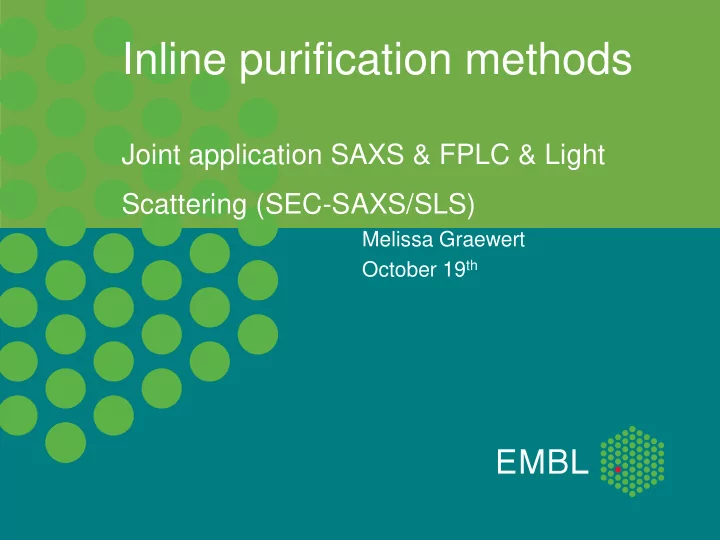

Inline purification methods Joint application SAXS & FPLC & Light Scattering (SEC-SAXS/SLS) Melissa Graewert October 19 th
The odd one out
What is SEC-SAXS, why does one need this? What information is gained with light scattering? How is SEC-SAXS done? Experiment and data analysis Sasha: Chromixs
Experiment I(s) X-ray beam s
Experiment I(s) X-ray beam s
What is SEC-SAXS/SLS, why does one need this? • Polydisperse samples • Aggregates • intrinsic property of the sample eg. monomer-dimer- oligomer equilibrium or incomplete formation of complexes
UV-Vis Starts HPLC BMS SEC-SAXS
UV-Vis BMS SEC-SAXS
Monomer (65 kDa) Dimer (122 kDa)
J. Synchrotron Rad. (2004)
Information extracted from the elution profile of an initially polydisperse solution of commercial BSA. Column: SHODEX 402.5- 4F. Flow rate: 150 µl min −1 . Injected volume: 5 µl at 88.8 g l −1 . ( a ) Chromatogram of the elution profile. The complex profile indicates the presence of several species. The main peak, at 17.04 min, corresponds to BSA monomer.
The SAXS instrument at the Barkla Laboratory of Biophysics. The set-up includes a Dectris PILATUS 300K-20Hz detector, three pin- hole optics and Rigaku FR-E+ Superbright X- ray generator.
SEC-SAXS mode
SEC-SAXS/MALLS mode
Light absorbance: ~ c, ε
Light absorbance: ~ c, ε Refraction: ~ c, dn/dc dual cell, deflection design
Light absorbance: ~ c, ε Scattering: ~ c, dn/dc, MW Refraction: ~ c, dn/dc
SEC-SAXS/MALLS mode
mixture monomer
M.O.S.E.S. (Microsplitting for Online Separation, Extended characterization and SAXS analysis) Phospholipase B of Legionella pneumophila (Lpn PlaB)
M.O.S.E.S. (Microsplitting for Online Separation, Extended characterization and SAXS analysis) — PlaB (batch, 4.5mg/ml) — PlaB, tetrameric peak lg I(q), a.u. q, nm -1
MW RALS = 230 ± 15 kD — PlaB (batch, 4.5mg/ml) lg I(q), a.u. — PlaB, tetrameric peak MW I (0 ) = 225 ± 15 kD MW Vol = 170 ± 30 kD MW DAMMIF = 203 ± 30 kD MW SEC ~ 100 kD q, nm -1
MW RALS = 230 ± 15 kD — PlaB (batch, 4.5mg/ml) lg I(q), a.u. — PlaB, tetrameric peak MW I (0 ) = 225 ± 15 kD MW Vol = 170 ± 30 kD MW DAMMIF = 203 ± 30 kD MW SEC ~ 100 kD q, nm -1
MW RALS = 230 ± 15 kD — PlaB (batch, 4.5mg/ml) lg I(q), a.u. — PlaB, tetrameric peak --- PlaB, dimeric peak MW I (0 ) = 225 ± 15 kD MW Vol = 170 ± 30 kD MW DAMMIF = 203 ± 30 kD MW SEC ~ 100 kD q, nm -1
Simultaneous Data Collection
M.O.S.E.S. (Microsplitting for Online Separation, Extended characterization and SAXS analysis) host Lipolytic active pathogen monomeric PlaB Activation Via dimeric state Electron micrograph of Legionella Self protection pneumophila wwww.wikimedia.org through inactive tetrameric PlaB
Batch mode or SEC-SAXS mode
What is SEC-SAXS /SLS, why does one need this? • Alternative strategy to study (moderatly) polydisperse samples How is SEC-SAXS done • Required sample amounts: at least 50 ul of > 5mg/ml • Sufficient buffer • Optimize your SEC run • If possible collect batch sample as well • Check for radiation damage, add 3% glycerol (if feasible)
Recommend
More recommend